Source: Glassnode; Compiled by: Baishui, Golden Finance
Summary
The macroeconomic environment remains uncertain, and global trade relations are being restructured. This uncertainty has led to increased volatility in the U.S. Treasury market and the stock market.
Faced with the severe economic situation, Bitcoin has recorded its largest drop in this cycle. Nevertheless, this is still within the typical range of previous adjustments during the bull market. In addition, the median decline in this cycle is still an order of magnitude lower than in previous cycles, highlighting that the demand situation is more resilient.
Liquidity across the digital asset ecosystem continues to tighten, reflected in declining capital inflows and stagnant stablecoin growth.
Investors are under considerable pressure and are currently facing the largest unrealized losses on record. However, most of these losses are concentrated on newer market participants, while long-term holders generally remain profitable.
Macro uncertainty remains prevalent
The macroeconomic situation is full of uncertainty, and the Trump administration aims to disrupt and restructure the status quo of global trade relations. Currently, US Treasuries are collateral and the foundation of the financial system, and the 10-year Treasury bond is regarded as the benchmark risk-free rate.
A major goal of the administration is to reduce the 10-year Treasury yield, and it has achieved initial success in the first few months of this year, with the yield falling to 3.7% as the broader market sold off. However, this was short-lived as the yield subsequently rose back to 4.5%, erasing this progress and causing huge volatility in the bond market.

We can quantify the disorderly behavior of the bond market through the MOVE index. The index is a key indicator of bond market stress and volatility, and is calculated from the implied 30-day volatility of the U.S. Treasury market based on option prices of different maturities.
By this measure, the volatility of U.S. Treasuries has risen sharply, highlighting the extreme uncertainty and panic among bond market investors.
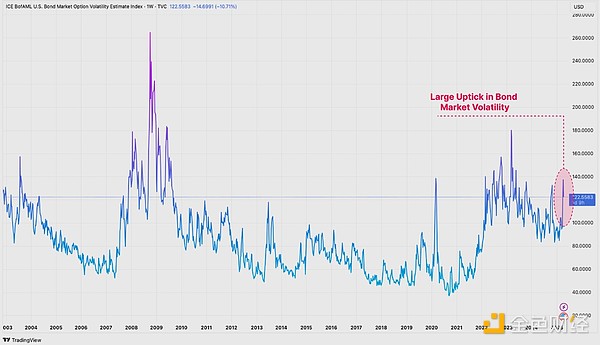
We can also measure the degree of chaos in the U.S. stock market using the VIX index, which measures the market's expectations of 30-day volatility in the U.S. stock market. Volatility in the bond market is also evident in the stock market, with the VIX currently recording volatility values similar to those during the 2020 COVID crisis, the 2008 global financial crisis, and the 2001 dot-com bubble.
Volatility in the underlying collateral of the financial system often leads to a withdrawal of investor capital and tightening of liquidity conditions. Given that Bitcoin and digital assets are among the most liquidity-sensitive instruments, they are naturally affected by volatility and the decline in risky assets.

Amid this turmoil, hard assets have continued to perform impressively. Gold prices continued to soar, hitting a new high of $3,300 as investors flocked to traditional safe-haven assets. Bitcoin initially sold off along with risk assets to $75,000 but has since recovered its multi-week gains to trade back up to $85,000, where it has remained flat since this volatility outbreak.
As the world adjusts to changing trade relations, gold and bitcoin are increasingly taking center stage as neutral global reserve assets. As such, one could say that the performance of gold and bitcoin during last week’s events sent a fascinating signal.
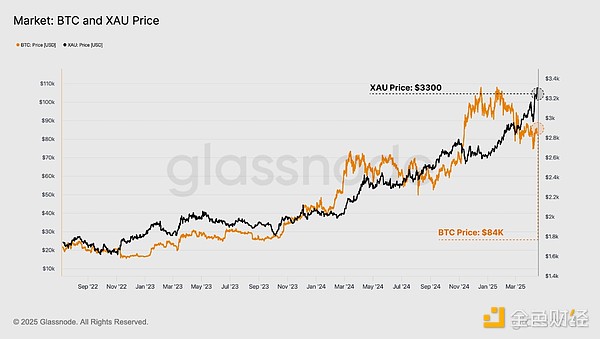
Bitcoin Remains Strong
While it is impressive that Bitcoin is still trading in the $85,000 region, the leading digital asset has still experienced significant volatility and declines in recent months. The asset recorded its largest decline in the 2023-25 cycle, with the largest correction falling -33% from its all-time high.
However, the decline is still within the typical range of previous corrections during bull markets. In previous macroeconomic events such as last week, Bitcoin has typically experienced sell-offs of more than -50%, highlighting a degree of robustness in modern investor sentiment towards the asset during adverse conditions.

To quantify the resilience of the current cycle, we can assess the rolling median retracement of all bull market structures.
2011: -22%
2011-13: -18%
2015-18: -11%
2018-21: -19%
2022+: -7%
The median retracement in the current cycle has been much smaller than all previous ones. Bitcoin’s declines since 2023 have become smaller and more controlled in nature, suggesting that demand conditions are more resilient and that many Bitcoin investors are more willing to hold during market turmoil.
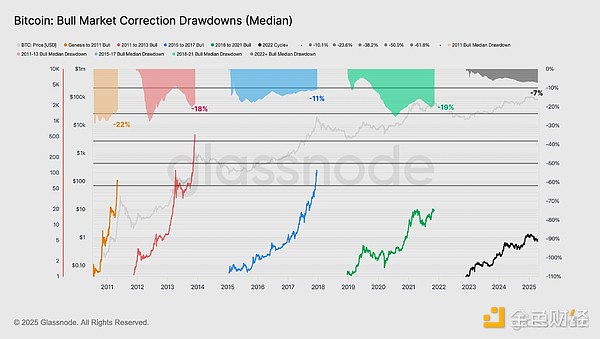
Liquidity Continues to Shrink
We can also assess how macro uncertainty is affecting Bitcoin’s liquidity profile.
We can measure Bitcoin’s internal liquidity through the realized capital metric, which calculates the cumulative net capital flows into the digital asset. Realized capital is trading at an all-time high of $872 billion, however, capital growth has compressed to just +0.9% per month.
Against the backdrop of a very challenging market, it is impressive that capital flows into the asset have remained positive. Given that the rate of new capital entering the asset is slowing, this also suggests that investors are currently less willing to deploy capital in the short term, suggesting that risk aversion may remain the default behavior for the time being.
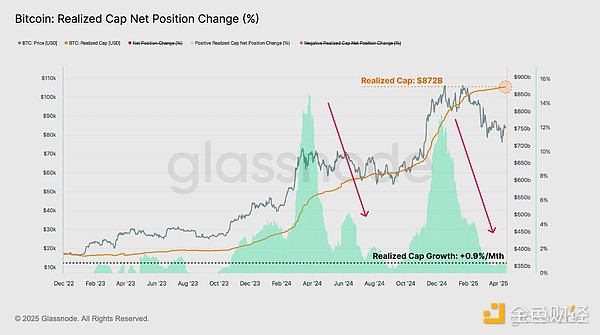
The realized profit and loss metric is an input component of realized market cap, allowing us to measure the difference between a token’s acquisition price and its value when spent on-chain.
By measuring realized profits and losses in BTC, we can normalize all profit and loss events relative to Bitcoin’s cyclically expanding market cap. Here we introduce a new variant, further refined by adjusting for volatility (7-day realized volatility), that helps explain the diminishing returns and growth rates as Bitcoin matures over its 16-year history.
Currently, profit and loss activity is relatively balanced, leading to the relatively neutral inflow rate mentioned earlier. This arguably reflects a saturation of investor activity within the current price range, and typically prevents a period of consolidation as the market attempts to find a new equilibrium.
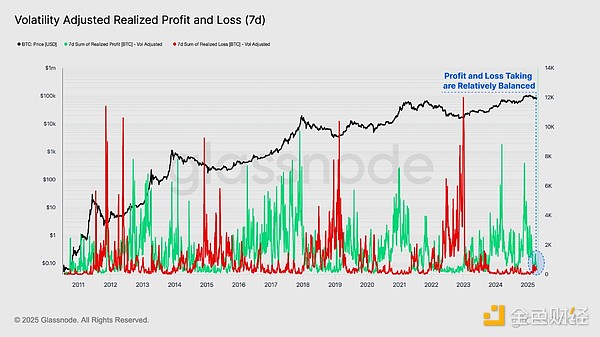
By calculating the difference between realized profits and realized losses, we can derive the net realized profit/loss metric. This metric measures the directional dominance of value flowing into/out of the network.
Using the volatility-adjusted net realized profit/loss metric, we can compare it to the cumulative median to distinguish between the two market regimes.
Values consistently above the median typically signal a bull market and net capital inflows.
Values consistently below the cumulative median are typically seen as bear markets, and Bitcoin will experience net capital outflows.
Markets frequently push investors to the brink of maximum pain, typically peaking at turning points in bull and bear cycles. We can see how the volatility-adjusted net realized profit/loss fluctuates around its long-term median, acting as a mean-reversion tool.
The metric has now reset back to its neutral median, suggesting that the Bitcoin market is currently at a critical decision point and drawing a line for bulls to re-establish support in the current price range.

Stablecoins have become a foundational asset class in the digital asset ecosystem, serving as quoted assets traded on centralized and decentralized trading venues. Assessing liquidity through the lens of stablecoins provides an additional dimension to our analysis, providing a holistic perspective on the state of digital asset liquidity.
Growth in stablecoin supply remains positive, but has slowed in recent weeks. This is further evidence that broader digital asset liquidity has shrunk, as measured by weakening demand for digital native dollars.

Examining Investor Pressure
Amid the ongoing market turmoil, it is important to assess the size of unrealized losses currently held by Bitcoin investors.
When measuring the realized market value of the losing supply, we note that it reached an all-time high of $410 billion during the market drop to $75k. When we examine the composition of unrealized losses, we can see that most investors are holding losses as high as -23.6%.
Currently, the realized supply held for losses is larger than during the May 2021 sell-off and the 2022 bear market. However, it is worth noting that from the individual investor level, the market has experienced a larger decline, as high as -61.8% and -78.6% respectively.
Despite the larger losses in actual holdings (given that Bitcoin is now a larger asset), individual investors face less challenges today compared to previous bear market periods.
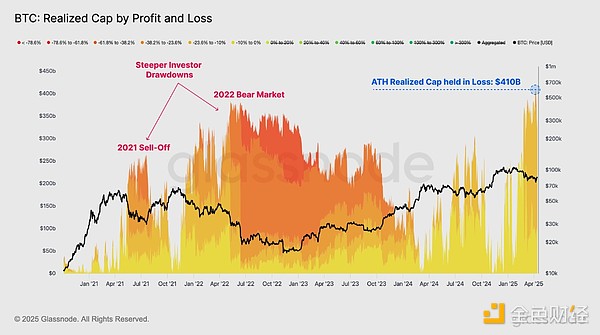
Despite the Realized Cap being in the red, the percentage of circulating supply in profit remains high at 75%. This suggests that most of the negative equity investors are new buyers of the top formation.
Interestingly, the profit supply percentage is approaching its long-term average. Historically, this has been a critical area to defend before the vast majority of currencies fall into losses and a key threshold between bull and bear market structures.
Bull markets are typically characterized by profit supply above its long-term average and will often find support at this level across the market.
Historically, bear markets are often accompanied by deep and prolonged periods below the long-term mean, and frequent declines from this level confirm declining profitability.
Similar to the Net Realized Profit/Loss metric, a bounce off the long-term average range would be a positive observation if it can be held.
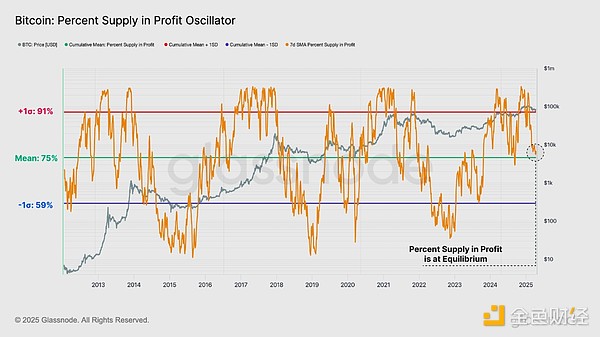
As the market continues to shrink, it is reasonable to expect the absolute size of unrealized losses to grow. To account for this and normalize for drawdowns of varying magnitude, we introduce a new indicator variable: unrealized losses per percent drawdown, which represents the percentage drop in losses in BTC relative to the all-time high.
Applying this indicator to the group of short-term holders shows that their unrealized losses have become considerable after the depth of the drawdown, comparable to the levels at the beginning of previous bear markets.

Nevertheless, unrealized losses are currently concentrated among new investors, while long-term holders remain in a state of unilateral profit. However, an important nuance is emerging, as WoC 12 points out, as recent top buyers gradually become long-term holders, the level of unrealized losses in this group may increase.
Historically, a large expansion of unrealized losses among long-term holders usually marks the confirmation of bear market conditions, although with a delay after the market peak. As of now, there is no clear evidence that such a change is underway.
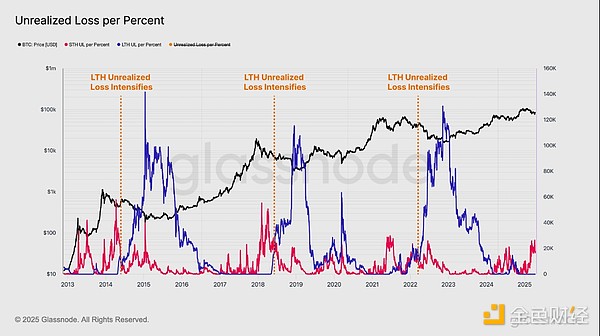
Summary
The macroeconomic situation remains uncertain, and global trade dynamics continue to change, leading to significant volatility in the U.S. Treasury and stock markets. Notably, the performance of Bitcoin and gold has remained strong during this challenging period. One can view this as a fascinating signal as the foundations of the financial system are entering a period of transformation and change.
Despite its remarkable resilience, Bitcoin has not been immune to the sharp volatility in global markets, which is its largest drop in the 2023-2025 cycle. This has greatly affected new market participants, who are now bearing the largest share of market losses. However, from the perspective of individual investors, the market has experienced more severe declines in previous cycles, especially during the bear market in May 2021 and 2022. In addition, mature and long-term investors are not affected by the continued economic pressure and are in a position of nearly unilateral profit.
 Catherine
Catherine

















